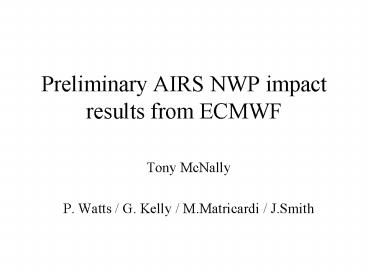Preliminary AIRS NWP impact results from ECMWF PowerPoint PPT Presentation
1 / 11
Title: Preliminary AIRS NWP impact results from ECMWF
1
Preliminary AIRS NWP impact results from ECMWF
- Tony McNally
- P. Watts / G. Kelly / M.Matricardi / J.Smith
2
AIRS monitoring at ECMWF
Archive departures and cloud flags/QC
NASA
OPERATIONAL 4D-Var system
2378 ch., all pixels
NESDIS/ORA
324 ch., 1 out of 18 pixels
AIRS data are passed through the operational
assimilation system every day to provide
real-time monitoring information (archived and
displayed on WWW).
3
Pressure ranked AIRS obs-calc biases
This is some text to hide the plot
Large and air-mass dependent biases (probably
systematic stratospheric temperature error in
ECMWF model / AMSUA)
Generally small and flat biases in the
mid-troposphere / lower stratosphere
Weighting function peak pressure
AIRS ranked channel index
Some polar biases in the surface sensitive
channels (possibly related to missed cloud
detection)
4
NWP impact experiments
Control assimilation system (ECMWF
operations) 12hr 4DVAR (T159 increments) T511
Forecast (conventional data 3xAMSUA 3 SSMI
2xHIRS 5xGEOS/MODIS SCAT) AIRS assimilation
system 12hr 4DVAR (T159 increments) T511
Forecast (conventional data 3xAMSUA 3 SSMI
2xHIRS 5xGEOS/MODIS SCAT AIRS) Trial
period 10 Dec 2002 to 31 Jan 2003 (18 Oct 2002
to 18 Nov 2002 performed at low resolution)
5
AIRS data usage in 4DVAR
- Input radiance data consists of sampled 324
channels from NASA / NESDIS-ORA - All channels flagged clear at a location are
assimilated (subject to blacklist) - After cloud screening good data are thinned to
a horizontal spacing of 120Km - Currently we do not attempt to assimilate
channels in the O3 band or 4.2 micron band - Currently we do not attempt to assimilate low
level channels over land - Flat (single global number rather than varying)
bias correction used for each channel - Very simple (and conservative) observation error
assigned to each channel (0.6 / 1.0 / 2.0K)
The initial emphasis here is on a conservative
use of the AIRS data (with simple observation
error models and bias correction aiding diagnosis
of the results)
6
Systematic analysis incrementsin temperature
Zonally averaged mean analysis increments (AN-FG)
as a function of altitude (EC model level)
CONTROL
CONTROL AIRS
Conclusion There do not appear to be any strong
air-mass dependent biases in the AIRS radiances
or the radiative transfer model used to
assimilate them
7
Impact of AIRS on ECMWF assimilation system
RMS analysis increment (AIRS) minus RMS analysis
increment (CTRL) 500hPa temperature averaged over
10 days
The assimilation of AIRS causes a clear reduction
in the 4DVAR analysis increments at radiosonde
locations
8
AIRS forecast impact
Day-3
RMS of 500hPa geopotential forecast error
averaged over 40 days (Dec 02/ Jan 03) AIRS
error minus CTRL error
Day-5
The assimilation of AIRS radiances shows a small
but consistent positive impact on forecast
quality in all areas
Day-7
9
AIRS forecast impact in the Tropics
10
Summary
The AIRS radiance assimilation system is
currently conservatively tuned (in terms of
observation errors and QC) and produces modest
positive impacts in all areas. The CONTROL
system (ECMWF operations) is currently performing
extremely well (3xAMSUA 3xSSMI 2xHIRS 5xGEOS) and
we should not expect large positive impacts from
AIRS on the mean forecast skill. The dream
scenario of the assimilation of AIRS data fixing
up a failed forecast has not yet been found
(lots of cloud / few busts) but we will keep
looking!
11
Next steps
- Finalize system for day one operational
implementation of AIRS - Investigate need for air-mass dependent bias
correction (CO2) - Improve cloud detection (polar areas / cross band
ideas) - Add assimilation of night time 4.2 micron data
- Look at reduction of observation error for key
channels - Look at more use of low-level data over land /
ice

